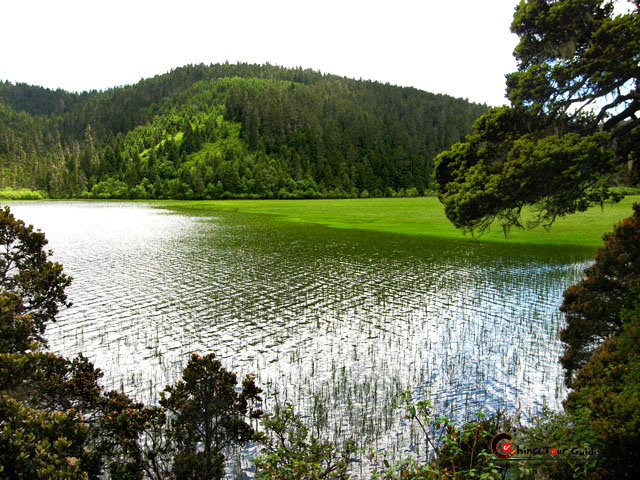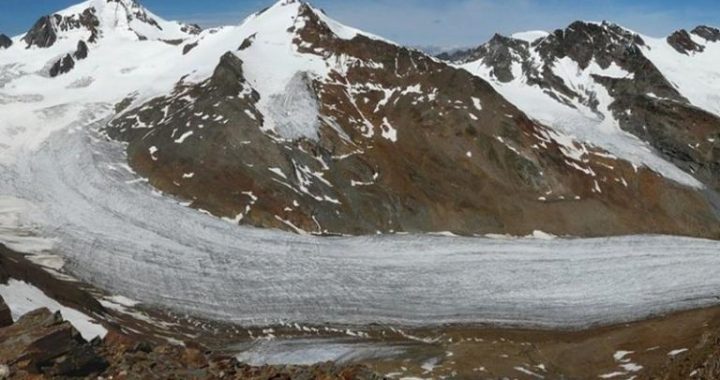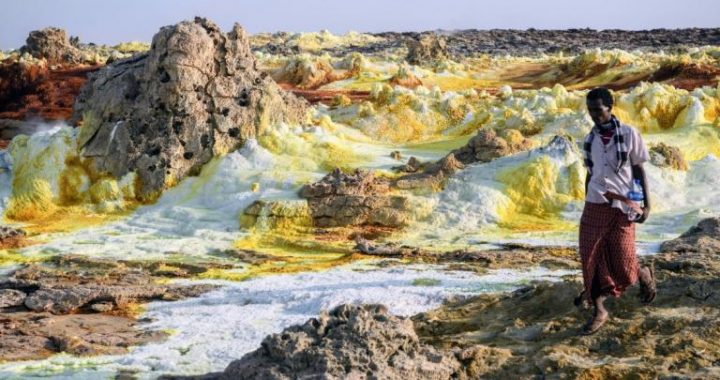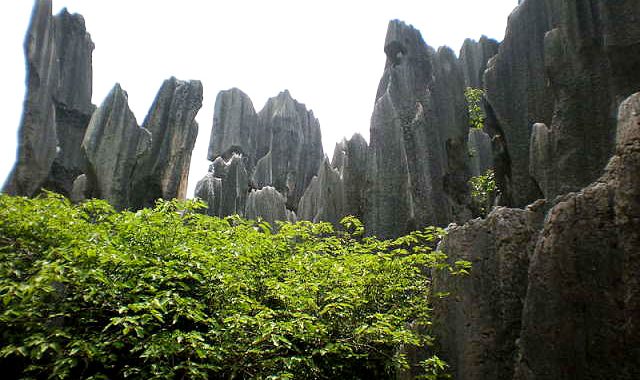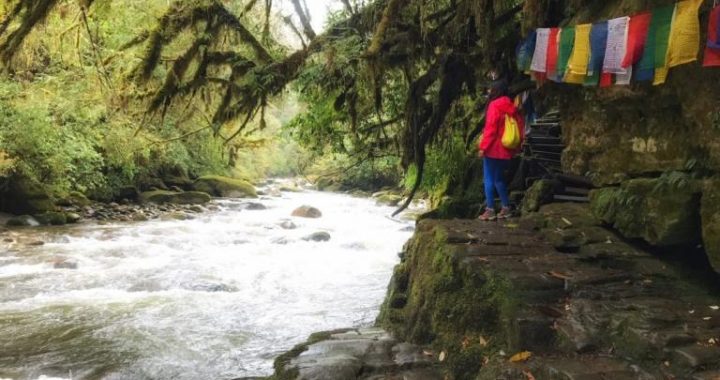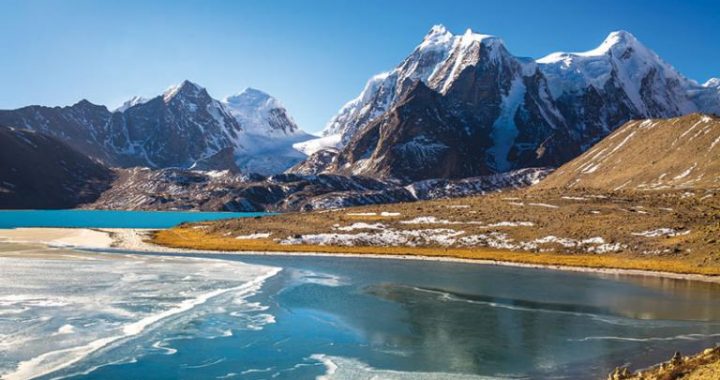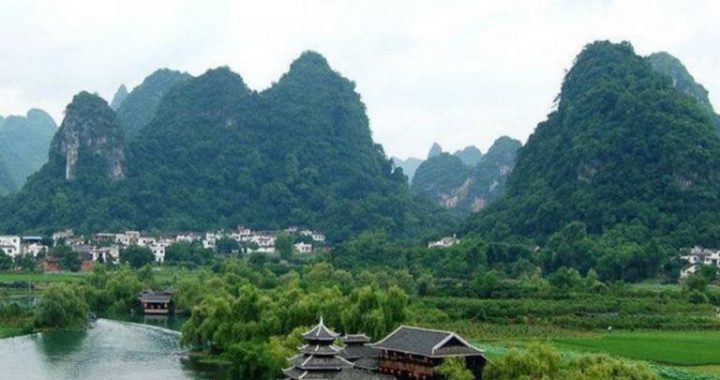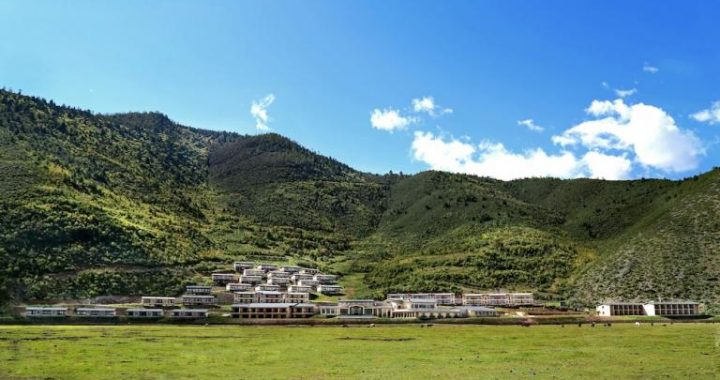Shangri-La beautiful forest
7 min readMoon Rock, Gongshan County
Andre Guibaut and Louis Liotard were leaders of a French anthropological expedition to the Nu River in 1936. They took this picture of a prominent peak in what is now northern Fugong County, looking west toward the crest of the Gaoligong Mountains. They called this Peak Brunhuber and Schmitz, apparently in honor of two German explorers murdered while crossing the Lancang-Nu divide south of here in 1909. The summit seen in the photo is the culmination of a sharp, steeply ascending granitic ridge that has a large hole in one section (out of view to the left).A major scenic vista when driving up the Nu River canyon, this feature is known locally as Moon Rock.The Nu River lies in the lowest and wettest of the three gorges, and supports subtropical forest in the valley bottom.E.C. Young traveled up the valley in 1905 and described the vegetation between Lushui and Fugong:”The billsides are chiefly covered with gras or brushwood, baving been largely denuded of forest, but numerous patches remain, and one encounters widely different ypes of vegetation as one ascends the mountains, the lower levelspresenting al the features of semi-tropical jungles, whilst pine and oak and other bardy trees are found on the upper slope.”Similar to Young’s description, all slopes in the foreground were clear of forest in 1936, apparently used as livestock pasture. It is likely that fire was used for this clearing. With vigorous fire suppression, these slopes became covered with a young forest by 2003.

Qizong Valley, Weixi County
The famous Chinese ecologist, Wang Qiwu, spent several years in the 1930s studying Yunnan’s forests. He found that Yunnan pine(Pinus yunnanensis), like the forest pictured here, is the most common forest cover in the province due to the widespread use of ground fires that maintain stands. Mature Yunnan pine trees are fire-tolerant and can withstand frequent ground fires. He speculated that subtropical broadleaf forests would likely take over from these sun-loving trees if not cut for fuel or burned.In this segment of the Jinsha River valley near Qizong, pine forests cover slopes in both the 1923 and 2002 images. But looking closely, you can seethat the density of the forest is much thicker today than 80 years earlier.The thinner, savanna-like stands of the 1920s were probably maintained by periodic fire, which most likely escaped from burning of agricultural felds in the valley bottom. Today, agricultural burning is controlled, and local fire brigades vigorously suppress fires that escape. This explains the dense pine forest, but what keeps the broadleaf trees from assuming dominance? Beneath this dense canopy is a diverse understory of broadleaf shrubs and small trees.Villagers maintain this near-monoculture of pine by continually cutting the understory shrubs and trees for fuelwood, ensuring continued dominance of the pine overstory. Only a few large pine trees are cut for house construction.
Sila Valley, Deqin County
Ecologist Wang Qiwu was so taken with the mid-montane forests of northwest Yunnan that he declared them to be”magnificent.”These rich, humid forests occur at middle elevations and are dominated by both coniferous trees of fir, hemlock, and spruce, and broadleaf trees, includingmaple, birch, and mountain ash. Joseph Rock traveled up this valley to Sila pass in 1923 and described the forest as:. the finest rain forest I had ever seen.”A forest of giant fir trees “with mighty trunks, more than 150 fet in beight. Great birch trees reared their crowns among the fir, forming a lovely canopy of foliage 90 feet above the ground.”Before descending into the valley, Rock took this photograph of his route through the forest. Apparently a wildfire had swept up the valley several years before, leaving stick-like standing dead trees on the slope.Today, the dead trees are gone and forest recovery is advancing well, but thelegacy of the fire remains. It is still easy to see the boundary between the burned young forest and unburned old-growth, even nearly a century later.
Deqin Valley, Deqin County
Another forest type common in the high and dry areas of northwest Yunnan is dominated by hard-leaf oak trees that have evergreen, holly-like leaves. Forests of these large trees can form near-continuous monocultures across mountain slopes. Such is the case above Deqin town, pictured across the valley here, where a vast stand of hard-leaf oak trees ascends the slope all the way to the upper treeline at nearly 4,200 meters(13,800 feet). In the 1923 photo, evidence of repeated fires can be seen in the pattern of the forest across the mountainside;a mosaic of tree canopy densities is a common characteristic of forests with complex fire histories. Today, there is no mosaic. It is now a uniformly dense, dark green canopy of oak. Clearly, large wildfires were common in early 20th century Deqin.
Chalitong Community Forest,Deqin County
The interesting part of this scene is the dome-shaped mountain on the left, which lies directly above the village of Chalitong in the Lancang River valley. High mountain pine(Pinus densata) covers the top half of the mountain. Here the forest cover has changed slightly in 80 years, despite continuous harvest for construction timber. Villagers use gravity to slide house logs down the steep mountainside. They leave telltale signs of this activity visible in photographs: vertical streaks running through the forest.These skid trails are very faint in the 1923 photo, but are much more noticeable by 2002, especially one very large trail.What these trails tell us is that, even under continuous or possibly increasing use during the past century, selective logging of house timber fromthis forest appears to be sustainable. In fact, Tibetan villages of the Lancang valley each administer regulations on use of their community forest. For house construction, there are typically rules on when a family can rebuild their house, the maximum number of logs to be taken, and the location from which the logs can be harvested. Age-old, yet flexible, these regulations appear to have served the community and the natural resources well.
Northern Lijiang Plain, Yulong County
This pine savanna lies at the transition between the warm conifer forest of the mountains and the arid, well-drained grasslands of the lower LijiangPlain. We can learn three interesting facts about land use change from this repeated sequence: Logging-Although Joseph Rock described the Yunnan pine in his picture as stunted, the trees are much smaller in 2003. The original stand was cut down and now there are two pine genotypes present in the area.The young trees visible in 2003 derive from local stock and have naturally regenerated on the site. The second genotype is from outside the area and was planted by air in 1993. This stock is not adapted to the site and is represented by scrubby, prostrate trees not visible in this scene.Fire-Rock’s pine savanna was likely maintained by periodic ground fire that swept through the area. In the foreground of the 2003 photograph is a prostrate oak shrub,a species that now has high ground cover in the area.No oak is visible anywhere in the old photograph, which probably saw fire frequent enough to limit survival of the oak, but not enough to kill the fire-tolerant pine. Livestock grazing the succulent new shoots probably also contributed to the lack of oak in the old photo. Wildfires are now actively suppresed.Grazing-The tall, thick cover of grass in the modern retake, as compared with Rock’s image, appears to indicate that livestock no longer graze here. Infact, we saw no recent evidence of grazing in the vicinity. During Rock’s time this area was along the main caravan route from Lijiang north to Lugu Lake and Sichuan, where many pack animals likely grazed on the way.
Lidiping Plateau, Weixi County
Although obviously rolling, Lidiping is as much of a plateau as can be found in the mountain and gorge country of northwest Yunnan. It is unusual and was commented on by nearly all of the early explorers who traveledthis main route of the Yunnan Tea and Horse Road here where it crosses the Jinsha-lancang divide. They also universally characterized it as wild and lonely with no permanent inhabitants. Crossing Lidiping was also feared because of its reputation as a place with lots of Lisu brigands.Despite the threat of brigands, all writers found Lidiping to be a lovely rolling upland with grassy, flower-filled meadows and thickly forested knolls.Some even compared it to the English countryside. Joseph Rock was effusive about the forests, describing them as immense trees and the only place where he had seen Lijiang spruce(Picea likiangensis) in pure stands. Governmentlogging in late 1980s took all the big spruce that Rock mentioned and is responsible for the deforested scene today on the Lidiping plateau.As we will see again in the forests of Haba Snow Mountain, there is another land use pattern that has played out for at least a century in northwest Yunnan. The roads and clearings from logging became attractive to migrating Yi, an ethnic group that occupies high, forested ridges in the region. The first Yi settlement started in 1972 with three families. It now consists of 80 families, most of whom migrated here in the mid-1990s after it was logged.
Lazhidi, Fugong County
Guibaut and Liotard took this photograph to illustrate the rice terraces along the Nu River, seen traversing the base of the slope beyond the cultivated fields. Of interest to us is the steep slope rising beyond the river. In1936 it was mostly cleared of forest and occupied by dryland(non-irrigated)fields and pasture. By 2003 only a few fields remained, the rest having been converted to a plantation of tung oil tree(Vernicia fordi). Native to subtropical China, oil from the seeds is widely used for wood finishing. The plantation resulted from a 20-year-old government agroforestry program meant to provide income for the universally poor inhabitants of the area. But as a poverty alleviation program, it failed. The program created so many new forests, all coming into production at the same time, that it swamped the market. The price plummeted to the point that it is no longer economically viable to harvest seeds and process the oil. The remote location of these plantations also created high transportation costs and they now lie idle.Fortunately, however, the program was a success in providing environmental benefits, including wildlife habitat and protection of steep slopes from soil erosion.
